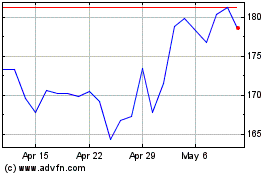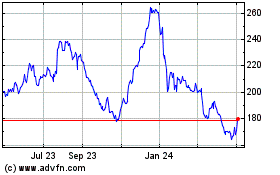FAA Probes Problem With Southwest Jet -- Update
March 14 2020 - 12:12AM
Dow Jones News
By Andy Pasztor
U.S. air-safety officials are investigating potential structural
problems affecting hundreds of Boeing 737 jets following an
in-flight incident that left a 12-inch rupture in the aluminum skin
of a Southwest Airlines plane.
Nobody was hurt on Monday night's flight, en route from Las
Vegas to Boise, Idaho, as the damaged aircraft descended to a safe
altitude and the pilots landed at their destination, according to
the carrier and the Federal Aviation Administration. The plane's
cabin gradually lost pressure but it stabilized after pilots
descended to a lower altitude, and oxygen masks never deployed.
The unusual event has prompted the agency to analyze whether
more-frequent inspections should be ordered to check the integrity
of the same part of the fuselage on similar 737 models.
The FAA analysis doesn't affect Boeing's 737 MAX models, which
are newer and currently grounded around the globe.
Pilots on Southwest Flight 1685 descended to 22,000 feet from
39,000 feet and continued safely to their destination.
"The aircraft was able to maintain a safe cabin pressure,"
according to an FAA statement, adding that the agency is
investigating.
A spokeswoman for Southwest said the plane was taken out of
service and is being repaired. "We consistently review our
maintenance programs based on new information and continually seek
opportunities to improve our robust safety practices," she
said.
Southwest has told the FAA that previously mandated maintenance
checks found external cracks on two other 737s in the same location
as with the plane involved in Monday's incident, according to
people familiar with the details. But those cracks -- on top of the
plane behind the cockpit -- didn't result in the kind of cabin
decompression that occurred on the flight this week, according to
information the carrier has provided to FAA inspectors.
Current FAA safety rules require inspections after every 1,500
flights to look for cracks on the exterior of that portion of the
fuselage. The jet that landed safely in Boise was inspected roughly
500 flights before Monday's incident, according to a person
familiar with the details.
Such maintenance checks for structural problems are routine
safety initiatives across all airliner models.
The most serious result of cracks in an aircraft's body is a
rapid decompression of the cabin. Such a problem can create a hole
in the fuselage, through which, in extreme cases, passengers can
even be sucked out in flight.
The FAA and Boeing have been devising enhanced maintenance
procedures for the same section of what is called the crown of 737
jets since 2008. The original safety directive was replaced by
revised inspection requirements in 2016 and again in 2017.
It is too early to know whether the FAA will require
more-frequent inspections, according to another person familiar
with the details. Before any decision, FAA experts are expected to
review the service and maintenance history -- as well as the
structural integrity of certain modifications -- affecting
Southwest and other U.S. operators of the widely used 737
models.
In 2016, the FAA's maintenance order called on airlines to look
for missing or loose fasteners and laid out other measures intended
to prevent cracks from spreading.
The 2017 safety directive said Boeing determined that the skin
of certain 737 models is subject to widespread metal-fatigue
damage. If the weakness isn't detected and corrected, according to
the FAA, it could "result in reduced structural integrity of the
airplane."
The FAA's deliberations come five months after the agency
ordered emergency structural inspections of some older 737 NG jets,
in order to detect unrelated cracking in crucial components that
help connect wings to fuselages. Subsequently, there were checks
and repairs, as necessary, of 737 NG jets that had flown fewer
trips. Dozens of planes world-wide have been grounded and repaired,
causing some schedule disruptions.
Southwest, for its part, has had regulatory tussles over the
years with the FAA regarding structural inspections and other
maintenance issues. More than a decade ago, after Congressional
investigators revealed Southwest flew tens of thousands of
passengers on 46 older aircraft without completing mandatory
structural inspections, the carrier agreed to pay a $7.5 million
civil penalty. Years later, metal fatigue opened a 5-foot gash on a
Southwest 737 that ended up making an emergency landing at a
military base in Arizona. There were no injuries.
Write to Andy Pasztor at andy.pasztor@wsj.com
(END) Dow Jones Newswires
March 13, 2020 23:57 ET (03:57 GMT)
Copyright (c) 2020 Dow Jones & Company, Inc.
Boeing (NYSE:BA)
Historical Stock Chart
From Jun 2024 to Jul 2024

Boeing (NYSE:BA)
Historical Stock Chart
From Jul 2023 to Jul 2024
